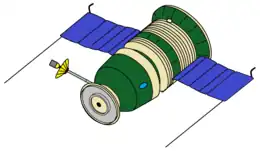Kosmos 154
Kosmos 154 (Russian: Космос 154 meaning Cosmos 154), also known as L-1 No.3P, was a Soviet test spacecraft launched from the Baikonur aboard a Proton-K rocket. It was a prototype Soyuz 7K-L1 launched by Proton. It was an uncrewed precursor to the Zond series.[1]
| Mission type | Test flight Moon Race |
|---|---|
| Operator | Soviet space program |
| COSPAR ID | 1967-032A |
| SATCAT no. | 02745 |
| Mission duration | 2 days |
| Spacecraft properties | |
| Spacecraft | Zond |
| Spacecraft type | 7K-L1 |
| Manufacturer | OKB-1 |
| Launch mass | 5375 kg [1] |
| Start of mission | |
| Launch date | 8 April 1967, 09:07:00 GMT |
| Rocket | Proton-K / Blok D |
| Launch site | Baikonur, Site 81/23 |
| Contractor | OKB-1 |
| End of mission | |
| Disposal | Failure |
| Decay date | 10 April 1967 |
| Orbital parameters | |
| Reference system | Geocentric[2] |
| Regime | Highly elliptical Earth |
| Periapsis altitude | 183 km |
| Apoapsis altitude | 223 km |
| Inclination | 51.6° |
| Period | 88.5 minutes |
| Epoch | 8 April 1967 |
Kosmos (satellite) (Crewed missions) | |
History
The spacecraft was designed to launch a crew from the Earth to conduct a flyby of the Moon and return to Earth. The primary focus was a Soviet circumlunar flight, which help document the Moon, and also show Soviet power. The test ran from the Zond program from 1967-1970, which produced multiple failures in the 7K-L1's re-entry systems. The remaining 7K-L1s were scrapped, ultimately replaced by the Soyuz 7K-L3.[3]
Objectives
Two test flights of the UR-500K/L1 system were performed in March and April 1967 under the designations Kosmos 146 and Kosmos 154. In April 1967, under the cover name Kosmos-154, the third model of the L-1 was placed into near-Earth orbit. Because of a control system failure that resulted in the premature jettisoning of the ullage motors, the main propulsion system of the Block-D did not ignite.[4] Kosmos 154 was one of the first Zond attempts. It was supposed to flyby the Moon but achieved Earth orbit only.[5]
Mission
Kosmos 154 was launched using a Proton-K carrier rocket, which flew from Site 81/23 at Baikonur. The launch occurred at 09:07 GMT on 8 April 1967. Kosmos 154 was operated in an Earth orbit, it had a perigee of 183 kilometres (114 mi), an apogee of 223 kilometres (139 mi), an inclination of 51.6° and an orbital period of 88.5 minutes. Kosmos 154 had a mass of 5,375 kilograms (11,850 lb).[1]
Kosmos 154 reached Earth orbit but the Blok D translunar injection stage failed to fire (ullage rockets, which had to fire to settle propellants in tanks before the main engine fired, were jettisoned prematurely). Kosmos 154 burned up two days later when orbit decayed, on 10 April 1967.[2]
Gallery
References
- "Cosmos 154: Display 1967-032A". nssdc.gsfc.nasa.gov. NASA. 27 February 2020. Retrieved 13 April 2020.
 This article incorporates text from this source, which is in the public domain.
This article incorporates text from this source, which is in the public domain. - "Cosmos 154: Trajectory 1967-032A". nssdc.gsfc.nasa.gov. NASA. 27 February 2020. Retrieved 14 April 2020.
- Harvey, Brian (2007). Soviet and Russian Lunar Exploration. Springer Science & Business Media. p. 138. ISBN 9780387739762.
- Grahn, Sven (29 August 2002 – 25 October 2017). "Kosmos 146 and Kosmos 154". www.svengrahn.pp.se. Retrieved 15 February 2018.
- Braeunig, Robert (15 May 2004 – 3 November 2017). "Lunar Spacecraft (Unmanned)". Retrieved 15 February 2018.


.png.webp)

